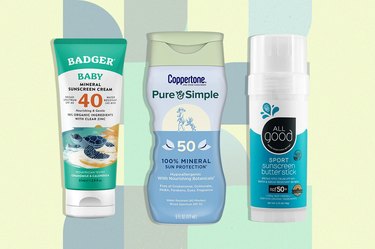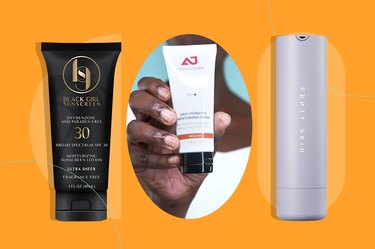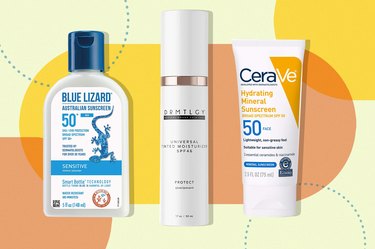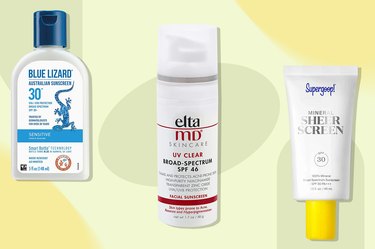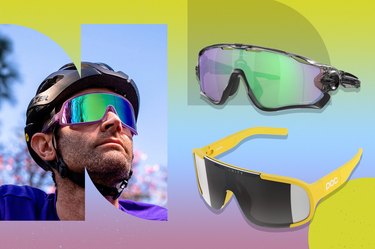
It can be relaxing to lie out in the sun all day, soaking up the rays and working on the perfect, summery tan. Because after all, what's the harm if you don't burn, right?
Turns out baking on the beach (or pool deck, patio or bike path) actually comes with risks, and that healthy glow might not be as healthy as you think.
Video of the Day
Video of the Day
Is a Tan a Sign of Skin Damage?
"Any time your skin is forming pigment and darkening it is trying to protect itself from damage to the skin," says Mary Stevenson, MD, a dermatologist at NYU Langone Medical Center.
That pigment is called melanin: It's present in your eyes, skin and hair naturally, and people with darker skin have more melanin to begin with.
But when your skin is exposed to the sun, it produces more melanin as a means of shielding itself from damage. This increase in melanin is what makes your skin appear darker when you tan, and it is evidence of skin damage, according to the U.S. Food and Drug Administration (FDA).
That damage comes from the ultraviolet light from the sun. UV rays can harm DNA in skin cells, which can lead to skin cancer, sunspots and signs of aging through the loss of elastin and collagen over time, according to Dr. Stevenson. However, these risks are even greater if you get a sunburn than a tan.
The Myth of the 'Base Tan'
It's a common misconception that having a "base tan" can protect people with fair skin against sunburn. "Darker skin does confer some protection against the sun, but it by no means prevents sun damage," Dr. Stevenson says.
That's true for those with naturally darker skin, too. Having more melanin means you have a lower risk of developing skin cancer, but UV exposure heightens the risk no matter your skin color, according to Columbia University.
"The extra melanin in tanned skin provides a Sun Protection Factor (SPF) of about 2 to 4; far below the minimum recommended SPF of 15," according to the FDA.
That's why dermatologists never recommend people "prime" their skin prior to sun exposure with a "base tan," says Gregory Papadeas, DO, a Colorado-based dermatologist and member of the American Academy of Dermatology.
The Only Safe Way to Get a Tan
Artificial tanning products, such as lotions, mousses and serums, are the safest ways to achieve a tanned look without the sun damage.
Sunless tanners commonly contain an ingredient called dihydroxyacetone (DHA), which reacts with amino acids on the skin to darken it and is approved for external use in cosmetics only, according to the FDA. Using DHA in spray tanning booths is not approved by the FDA, as it may cause you to inhale or ingest the ingredient.
If you do decide to use a sunless tanner, according to the FDA, make sure to:
- Skip aerosol products
- Apply the product in a well-ventilated area
- Avoid your eyes and lips
If you'd rather avoid DHA entirely, look for DHA-free bronzers or tinted moisturizers, which will wash off when you shower.
Keep in mind you should be extra cautious with sunscreen if you are using self-tanning products, Dr. Papadeas says. "You think that you're tan, but you're not really tan, so you can be more prone to sunburn."
Tip
Indoor tanning is no safer than sun exposure. Tanning beds also increase the risk for skin cancer, according to the Skin Cancer Foundation.
How to Protect Your Skin From the Sun
The best way to protect your skin from sun damage (and yes, that includes tans) is to avoid the sun's rays when they are the strongest between 10 a.m. and 4 p.m., according to the CDC. If you are outside during those hours, it's important to use sunscreen with an SPF of 15 or higher and wear protective clothing, hats and sunglasses.
Dermatologists recommend wearing sunscreen every day, even if it's cloudy, you aren't susceptible to sunburns or you don't plan to spend the entire day outside, according to the Skin Cancer Foundation.
When used properly, sunscreen prevents tanning, according to Johns Hopkins Medicine. But no sunscreen blocks 100 percent of UV rays, so it is still possible to tan (or burn) after applying SPF if you're not reapplying regularly.
Shop Our Picks for the Best Sun Protection
So, How Bad Is It Really to Get a Tan?
It's not as dangerous as a burn, but tanning is sun damage, plain and simple.
While it's most important to avoid sunburns that peel or blister, according to Dr. Papadeas, it's safest to avoid tanning entirely and always protect your skin from the sun.
Getting even just one sunburn that blisters and peels when you're a kid or teen more than doubles your chance of developing melanoma later on, according to the Skin Cancer Foundation.
So, while you probably don't need to panic about a light tan, it's always safer to slather on some sunscreen before heading outdoors.
Is this an emergency? If you are experiencing serious medical symptoms, please see the National Library of Medicine’s list of signs you need emergency medical attention or call 911.

